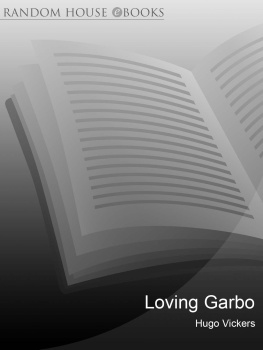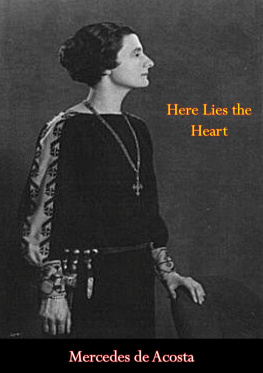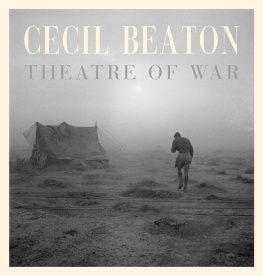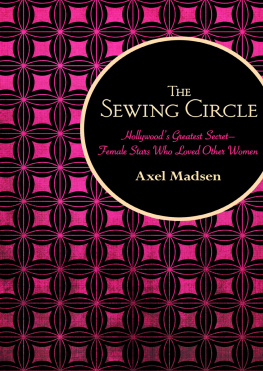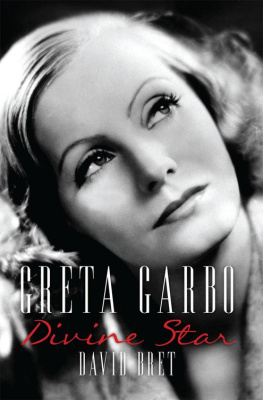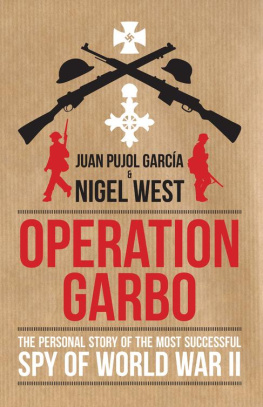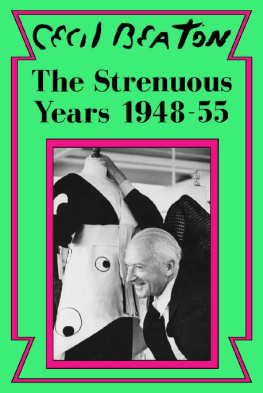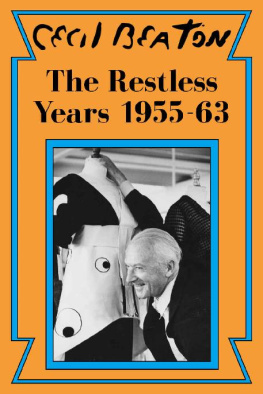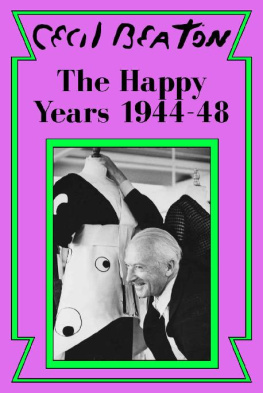Contents
About the Author
Hugo Vickers was born in 1951, and educated at Eton and Strasbourg University. He is the author of biographies of Vivien Leigh and Gladys, Duchess of Marlborough, and widely recognised as one of the countrys leading authorities on the Royal Family. His interest in Greta Garbo was fostered when researching his authorised life of Cecil Beaton, for whom he has acted as literary executor since 1987.
Vickers is a full time writer and an enthusiastic obituarist, lecturer and traveller. He broadcasts in Britain and has regular radio links with Australia and Canada. He divides his time between a moated Jacobean manor house in Hampshire and London.
Loving Garbo
The Story of Greta Garbo, Cecil Beaton and Mercedes de Acosta
Hugo Vickers

Bibliography
The traditional form of bibliography seems to me to be unsatisfactory, listing a great number of books that the author purports to have consulted, without regard to their merit. All books quoted in this book are fully listed in the sources. I therefore propose to give the reader a more informed guide to further reading about the principal characters in this book.
Cecil Beaton
The fullest account of Cecil Beatons life is in the biography he authorised me to write, Cecil Beaton (lately republished by Weidenfeld, 1993, updated in minor ways since the original publication in 1985). Cecil Beaton published many books during his lifetime, of which the six volumes of his diaries (from Weidenfeld) give a good portrait of himself and his friends. These are The Wandering Years (1961), The Years Between (1965), The Happy Years (1972), The Strenuous Years (1973), The Restless Years (1976) and The Parting Years (1978). A composite volume, edited by Richard Buckle, is called Self Portrait with Friends (originally published by Weidenfeld in 1979, and now re-published by Pimlico, 1991). The volume which caused Greta Garbo particular distress was The Happy Years.
Of Cecil Beatons other books, he wrote of Garbo in The Book of Beauty (Duckworth, 1930) and in Cecil Beatons Scrapbook (Batsford, 1937). These books are both extremely rare and in consequence change hands for large sums of money. His early book of memoirs, Photobiography (Odhams, 1951), is superficial, charming and easy to read. Again it contains material on Garbo.
Cecil Beaton covered his war experiences in Near East (Batsford, 1943) and Far East (Batsford, 1945). He wrote an evocative history of his time at Ashcombe, the house in the valley in Dorset, in Ashcombe (Batsford, 1949). An important, original look at twentieth-century fashion, combining the designers with those who made the styles fashionable, is given in his book The Glass of Fashion (originally published in 1954, and re-printed by Cassell in 1989). This should be a must for all fashion students.
For those wishing to study his photography, there is The Best of Beaton, a handsome volume of photographs, now very rare (Weidenfeld, 1968), Beaton in Vogue by Josephine Ross (Thames & Hudson, 1986), and Cecil Beaton, A Retrospective, edited by David Mellor (Weidenfeld, 1986), with essays on various aspects of his work. Beatons royal photography is well covered in his book Royal Portraits (Weidenfeld, 1963, now hard to find) and in Sir Roy Strongs lavish volume, Cecil Beaton, The Royal Portraits (Thames & Hudson, 1988). Charles Spencer produced a useful and well illustrated volume on Beatons design work, Cecil Beaton, Stage and Film Designs (Academy, 1975).
Cecil Beatons complete bibliography can be found in my biography of him, pp. 5901.
Greta Garbo
There are innumerable books about Greta Garbo, none of which is particularly satisfactory. Barry Pariss new biography from Knopf (1995) is likely to supersede any so far written. Otherwise the fullest and most reliable is John Bainbridges Garbo (Frederick Muller, 1955), a copy of which the star is reputed to have thrown overboard on a trans-Atlantic crossing. I would also recommend Garbo A Portrait by Alexander Walker (Weidenfeld, 1980).
For illustrated volumes, the best is Greta Garbo Portraits 19201951 (Rizzoli, New York, 1986), followed by Terence Peppers The Man who Shot Garbo Clarence Sinclair Bull (National Portrait Gallery, 1989). The films are well covered in The Films of Greta Garbo by Michael Conway (with a good introductory essay by Parker Tyler), published by the Citadel Press, New York, 1963). I would single out, too, Franoise Ducourts Greta Garbo La Somnambule (Stock, Paris, 1991), Patrick Brions Greta Garbo (Le Chne, Paris, 1985) and The Divine Garbo by Frederick Sands and Sven Broman (Sidgwick & Jackson, 1979). Antoni Gronowiczs Garbo Her Story (Simon & Schuster, 1990) is now wholly discredited as a figment of his imagination.
Karen Swenson of Los Angeles is preparing a biography of Garbo. The Kindness of Strangers by Salka Viertel (Holt, Rhinehart & Winston, New York, 1969) is also recommended.
Mercedes de Acosta
Mercedes de Acostas memoirs, Here Lies the Heart, were published by Andr Deutsch in 1960. They were reprinted in 1975 by a feminist press in New York, and are hard, though not impossible, to find. A full biography is currently being prepared by Liza Stelle of New York.
Mercedes also makes appearances in various books about Marlene Dietrich. The best Dietrich books are Marlene Dietrich by Maria Riva (Bloomsbury, 1992), Marlene Dietrich by Steven Bach (Harper Collins, 1992), Dietrich by Donald Spoto (Bantam, 1992), Marlene, the Life of Marlene Dietrich by Charles Higham (W.W. Norton, New York, 1977) and Marlene Dietrich Un amour par tlphone by Alain Bosquet (La Diffrence, Paris, 1992). There is also the study by Gaylyn Studlar, In the Realm of Pleasure, subtitled Von Sternberg, Dietrich and the Masochistic Aesthetic (University of Illinois Press, 1988).
Mercedes also appears in the only biography yet published on Eva Le Gallienne, Shattered Applause by Robert A. Schanke (Southern Illinois University Press, 1992).
Acknowledgements
The Cecil Beaton papers, housed at St Johns College, Cambridge comprise a large part of the material for this book. I did not need to trouble the College during the writing, since I had retained my notes from my 1985 biography of Beaton, and I drew from these.
Cecil Beatons letters to Garbo probably no longer exist, but the carbon copies he made are in his papers. So are 37 of the 50 letters that Garbo wrote him. A dozen or so are not. These were removed from his house at Broadchalke, probably without his knowledge, though this cannot now be proved. They were sold in New York in 1990, and I purchased three of them myself. I also purchased Hal Burtons letters from Cecil Beaton in 1988.
The majority of papers relating to Cecil Beaton and Greta Garbo remain sealed indefinitely, but as I have frequently pointed out to would-be researchers, there is little more than what originally appeared in his diaries, my biography, or finally in this book. Beatons letters and diaries are the copyright of his literary executors. Garbos are the copyright of her niece, Mrs Gray Reisfield, of New York City. Mrs Reisfield has explained her reasons for not wishing her aunts letters quoted directly, so these are paraphrased.
Mercedes de Acostas papers are in the Rosenbach Museum in Philadelphia. I spent many happy days researching there, and am particularly grateful to the former curator of the Rosenbach Museum and Library, Leslie A. Morris, for her help.
Next page
